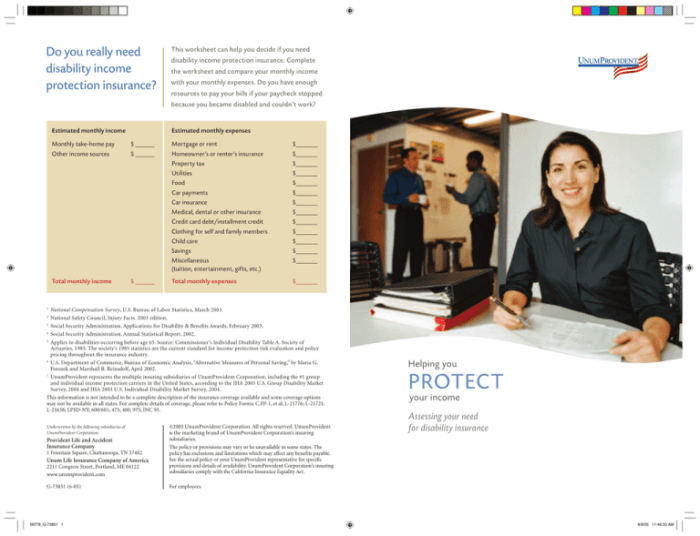P is self-employed and owns an individual disability income policy – P’s journey as a self-employed individual highlights the unique challenges and opportunities associated with securing disability income protection. This case study delves into P’s individual disability income policy, exploring the factors that influenced their decision, the potential impact of disability on their financial well-being, and recommendations for optimizing their coverage.
1. Individual Disability Income Policies

Individual disability income policies provide income protection for individuals who are unable to work due to a disability or illness. These policies offer a variety of benefits, including:
- Replacement of lost income
- Coverage for both short-term and long-term disabilities
- Tax-free benefits
There are different types of individual disability income policies available, including:
- Own-occupation policiesprovide benefits if you are unable to work in your own occupation.
- Any-occupation policiesprovide benefits if you are unable to work in any occupation.
- Short-term disability policiesprovide benefits for a limited period of time, typically up to 2 years.
- Long-term disability policiesprovide benefits for a longer period of time, typically up to age 65 or the end of your working life.
When choosing an individual disability income policy, it is important to consider factors such as your income, occupation, and health history.
2. Self-Employment and Disability Income

Self-employed individuals face unique challenges in obtaining disability income insurance. Unlike employees, self-employed individuals do not have access to employer-sponsored disability insurance. This means that they must purchase their own disability insurance policies.
There are several strategies that self-employed individuals can use to secure adequate disability income protection:
- Purchasing an individual disability income policyis the most common way for self-employed individuals to obtain disability income protection.
- Participating in a professional associationthat offers disability insurance as a member benefit.
- Setting up a disability trustcan help to ensure that disability benefits are used to pay for eligible expenses.
Here are some examples of self-employed individuals who have successfully obtained disability income insurance:
- P is a self-employed graphic designer who purchased an individual disability income policy. P’s policy provides benefits of $5,000 per month for up to 5 years in the event that P is unable to work due to a disability or illness.
- Q is a self-employed lawyer who participates in a professional association that offers disability insurance as a member benefit. Q’s association policy provides benefits of $10,000 per month for up to 10 years in the event that Q is unable to work due to a disability or illness.
3. Case Study
P’s Individual Disability Income Policy

P’s individual disability income policy provides benefits of $5,000 per month for up to 5 years in the event that P is unable to work due to a disability or illness. The policy has a 90-day waiting period, which means that P must be unable to work for 90 days before benefits will begin.
P chose to purchase this policy because P is the sole income earner in their family and P wanted to ensure that their family would have financial security in the event that P was unable to work.
If P becomes disabled and is unable to work, P will receive $5,000 per month in benefits. These benefits will help P to cover their living expenses, such as their mortgage, car payment, and groceries. P’s policy also includes a cost-of-living adjustment, which means that P’s benefits will increase over time to keep pace with inflation.
4. Recommendations for P: P Is Self-employed And Owns An Individual Disability Income Policy

Here are some specific recommendations for P regarding their individual disability income policy:
- Consider increasing the benefit amount.P’s current benefit amount of $5,000 per month may not be sufficient to cover their living expenses if they become disabled. P should consider increasing their benefit amount to $7,500 or $10,000 per month.
- Consider decreasing the waiting period.P’s current waiting period of 90 days is relatively long. P should consider decreasing their waiting period to 30 or 60 days to ensure that they will receive benefits sooner if they become disabled.
- Review the policy regularly.P should review their policy annually to make sure that it still meets their needs. P should also consider increasing their benefit amount or decreasing their waiting period as their income and circumstances change.
FAQ Corner
What are the unique challenges faced by self-employed individuals in obtaining disability income insurance?
Self-employed individuals may face challenges in obtaining disability income insurance due to factors such as irregular income, lack of employer-sponsored coverage, and higher premiums compared to traditional employees.
What strategies can self-employed individuals use to secure adequate disability income protection?
Strategies include purchasing an individual disability income policy, exploring group coverage options through professional organizations or associations, and considering supplemental insurance products.
What factors should P consider when reviewing their individual disability income policy?
P should regularly review their policy to ensure it aligns with their current income and financial needs, considering factors such as coverage amount, benefit period, waiting period, and inflation protection.